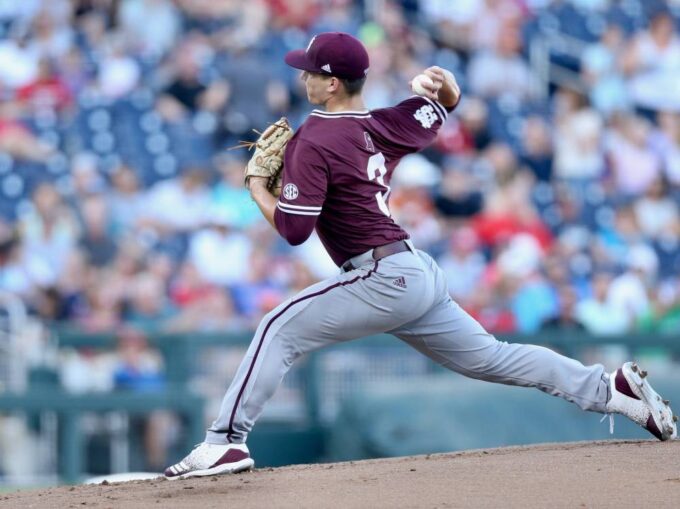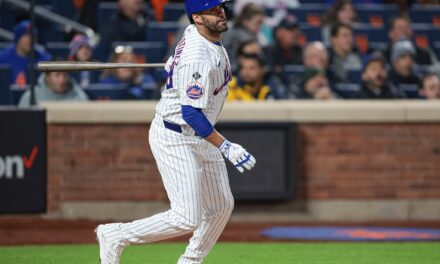
JT Ginn
The Mets front office and amateur scouting department made a shrewd move in 2019 when they took right-handed pitcher Matthew Allan in the third round of the 2019 draft.
It was shrewd because Allan was a first round talent that dropped due to expected asking price and the fact that the Mets took a legitimate first rounder in Brett Baty and second rounder in Josh Wolf (both of them expected to sign around slot value).
The move by Brodie Van Wagenen and company worked when they were able to sign all three of the high-end players.
The Mets strategy was much of the same in 2020 despite having only five rounds in the draft according to Van Wagenen, “What we focused on and prioritized – similar to last year – is high-end, impact talent.”
They did that by taking prep outfielder Pete Crow-Armstrong with the 19th overall pick, high upside right-handed pitcher J.T. Ginn in the second round (52nd overall), and SoCal prep outfielder Isaiah Greene with their compensation pick (69th).
Mets bonus pool money tops out at $7,174,700 this year. And remember, that undrafted free agents can only receive a maximum $20,000 signing bonus.
Van Wagenen – former co-head of CAA – wanted to be aggressive again, “This year, we had the opportunity again to be very aggressive in targeting players that frankly, sat atop of our overall draft board.”
Crow-Armstrong, 18, has been called a magician in center field and has the type of potential bat the Mets see at the top of a lineup with his plus speed and above average hit tool. He was ranked as high as No. 10 (The Athletic) on pre-draft lists.
Ginn – a draft eligible sophomore – was taken with the 30th overall pick in the 2018 draft by the Dodgers out of high school, but turned down their $2.4 million offer to head to Mississippi State. The Scott Boras client (as is Allan) had Tommy John surgery in early March and isn’t expected to return until spring of 2021. The right-hander is a first round talent that was rated as high as No. 23 (Baseball America) pre-draft.
Mets vice president of amateur scouting Tommy Tanous had high praise for 21-year-old Ginn, “This is a rare combination of turbo sink, as we call it, with strikeout ability. It’s an out-pitch curveball, an at-will curveball that he throws for strikes. It’s a super athletic kid. He’s got all the qualities of being a top-of-the-rotation guy.”
Then with the 69th overall pick – compensation for the Phillies signing former Mets pitcher Zack Wheeler – the Mets got the toolsy Greene. The rankings varied quite a bit for Greene, with as high as No. 46 from Baseball America all the way down to 126 from FanGraphs.
The left-handed hitter has the chance to stick in center field with his plus speed (98.69 percentile of draft class). Greene has been comped to such outfielders as Garret Anderson and Michael Brantley, given his ability to consistently hit line drives and good hand-eye coordination. There’s not much power in his game to this point, but the 6’1”, 180 pound athlete has a sweet swing and the pop could come as he fills out.
Mets certainly think Greene was better than a 69th overall pick, “He does not belong where we took him,” said Tanous.
Baseball America did a feature with their writers choosing 12 picks they loved from Day 2 of the draft with both Ginn and Greene making the list.
Three college picks rounded out the draft for the Mets; shortstop Andrew Walters at No. 91, catcher Matthew Dyer at No. 120, and right-handed pitcher Eric Orze with the No. 150 pick.
Here’s the assigned bonus values for each Mets pick:
- No. 19 – $3,359,000
- No. 52 – $1,403,200
- No. 69 – $929,800
- No. 91 – $647,300
- No. 120 – $478,300
- No. 150 – $357,100
The Mets likely took the last three players in the draft with the notion that all three will take below their slot values to give them more money available for the top three picks.
Van Wagenen expressed optimism that the Mets will sign all of the selected players and was happy with the overall draft, “I don’t think we could’ve possible imagined that type of talent could be coming into the organization with a five round draft.”















